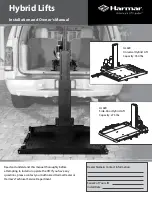
VR9105V, F AND VR9205V, F DIRECT IGNITION GAS CONTROL WITH INTEGRATED 1:1 REGULATOR
69-2471EF—01
6
STARTUP AND CHECKOUT
Perform Gas Leak Test
WARNING
Fire or Explosion Hazard.
Can cause property damage, severe injury
or death.
Perform Gas Leak Test every time work is done on
a gas system.
IMPORTANT
Do not spray soap and water solution on the gas
control. Do not use an excessive amount of soap
and water solution to perform the gas leak test.
These can damage the control.
Gas Leak Test
1.
Apply rich soap and water solution onto pipe con-
nections. Bubbles indicate a gas leak.
2.
If a leak is detected, tighten the pipe connections.
3.
Light the main burner. Stand clear of the main
burner while lighting to prevent injury caused from
hidden leaks that could cause flashback in the
appliance vestibule.
4.
With the main burner in operation, apply rich soap
and water solution onto the pipe joints (including
bushings) and the control inlet and outlet.
5.
If another leak is detected, turn the gas control to
off, tighten the joints and pipe connections.
6.
Replace the part if a leak cannot be stopped.
Turn On System and Main Burner
Follow appliance manufacturer instructions or turn
thermostat up to call for heat.
Adjustment
Do not adjust regulator if cap is sealed.
Refer to the instructions below for making adjustments to
the offset or 1:1 gas/air regulator setting if the cap is not
sealed.
IMPORTANT
1. Do not exceed input rating stamped on appli-
ance nameplate or manufacturer's recom-
mended burner orifice size(s). Make certain
primary air supply to main burner is properly
adjusted for complete combustion. Follow appli-
ance manufacturer instructions.
2. IF CHECKING GAS INPUT BY CLOCKING GAS
METER: Make certain there is no gas flow
through the meter other than to the appliance
being checked. Other appliances must remain
off with the pilots extinguished (or deduct their
consumption from the meter reading). Convert
flow rate to Btuh as described in form 70-2602,
Gas Controls Handbook, and compare to Btuh
input rating on appliance nameplate.
3. IF CHECKING GAS INPUT WITH MANOME-
TER: Make sure the plug is not connected to the
coil connector before removing outlet pressure
tap plug to connect manometer (pressure
gauge). Also pull out the plug from coil connector
when removing the gauge and replacing pres-
sure tab plug. Before removing inlet pressure tap
plug, shut off gas supply at the manual valve in
the gas piping to the appliance or, for LP, at the
tank. Also shut off gas supply before disconnect-
ing manometer and replacing plug. Repeat Gas
Leak Test at plug with main burner operating.
Pressure Tap and Pressure Port
The combination gas control is provided with 1/8-in. NPT
pressure tap plugs. The 1:1 regulator is provided with M5
threaded hole or 6 mm O.D. fitting connection (optional) to
sense appliance air pressure. Fitting connection accepts
3/16 in. I.D. rubber hose.
CAUTION
To ensure a safe closing of the valves, it is
essential that power supplied to the gas valve
be disconnected.
1:1 Gas/Air Regulator/Offset adjustment
on outlet pressure
• If cap screw is not sealed, remove cap screw to
expose adjustment screw.
• Check gas supply pressure to the appliance with the
valve flowing gas at max using a pressure gauge
connected to the inlet pressure tap.
• Control the fan to produce the air pressure difference
stated by the appliance manufacturer.
• Energize the gas valve in order to have gas supplied to
the burner. The main burner should ignite within 3
seconds.
• Turn the outlet pressure adjustment screw slowly until
the desired pressure is obtained. Turn adjustment
screw counter clockwise to increase or clockwise to
decrease outlet pressure.
• Replace and tighten cap screw and pressure tap plugs.


































